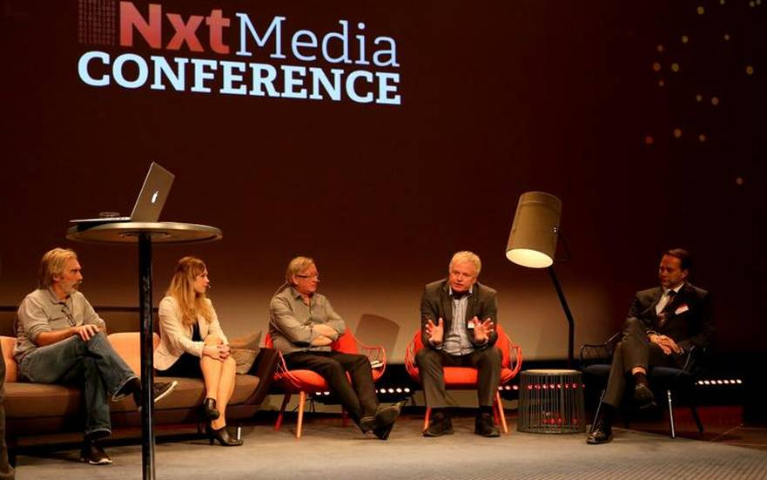Harnessing multi-skilled networks for internationally-recognised innovation
Norwegian technology cluster NxtMedia seeks to stimulate journalism innovation through encouraging partnerships, research and product development across national and international media, technology and academic boundaries. Formed in 2011 and headquartered in Trondheim, NxtMedia supports personalized product development, data journalism initiatives and creating new narrative forms. The network identifies broad areas of interest, develop related technologies and seek and exploit commercial opportunities for both the technology and content.
Its key partners include regional newspapers Adresseavisen and Trønder-Avisa, the Norwegian Media Business Association, state broadcaster NRK, media group Jysk Fynske Media (DK) and a variety of colleges, universities and technology companies from across the Trondheim area and beyond, the most prominent among them the national Norwegian University of Science and Technology (NTNU).
Rolf Dyrnes Svendsen, editor and chairman at NxtMedia, describes it as a “project enabler”, with a core aim to foster collaboration across the sector to prompt and support innovation. Building, supporting and enabling the network is key, he adds.
“The networking process brings together interested partners and builds relations. The enabling process is identifying possibilities according to partner’s and member’s interests and accelerate project from idea to execution,” Svendsen continues.
There are currently over 50 members and associates of the network, which is formed as an association, and two project managers.
Methods, approaches and projects
NxtMedia is powered by two priorities: networking and enabling. Members of the network are drawn together around common goals or interest areas, and then supported in finding opportunities and resources to make projects happen.
Svendsen explains that the process “identifies possibilities according to partner’s and member’s interests and accelerate projects from idea to execution”.
Collaboration between diverse partners is a key element of the process. “Academic and industrial groups work closely together, from the early analysis of technological needs to the deployment and evaluation of prototypes running on real data,” Svendsen adds.
Throughout the networking, project development and execution, a broad range of research and development methods are used. Networking opportunities include the NxtMedia Conference and NODA data journalism conference, alongside more informal conversations such as seminars, breakfast meetings and academic events.
Once a project is active and in a live research and innovation phase, the specific research methods are decided upon depending on the priorities of the project. For example RecTech (detailed below) uses Living Labs. This approach sees audiences and users provided with technologies in their own home or work environment. Researchers can then study a prototype or product’s use and effectiveness in situ, rather than within a lab environment.
In addition to understanding users, researchers are also located within the media houses, so have a strong relationship with the newsroom and content creators.
Two specific projects to have emerged under the personalized media recommendation systems area include RecTech and Contextual.
RecTech, supported by the BIA program at the Research Council of Norway, is a large industry-led research project developing new approaches to deep content analysis and user intelligence for news recommendation. Over a four-year period, and with more than €4m, new components will be developed and deployed in a Living Lab environment via project partners Adresseavisen and NTNU. Other partners include data management firm Cxense and Technical Research Centre of Finland (VTT).
Contextual, funded by the FORNY programme at the Research Council of Norway, evaluates how elements of the recommender technologies can be commercialized.
Looking to the future of recommendation systems and describing NxtMedia’s aspirations in this field, Svendsen points to global ambitions for rollout and market development. The “vision is to be an international powertrain for this technology”.
Innovation and dissemination
NxtMedia’s activities also move beyond creating new products and tools. It’s interested in how innovation happens and explores innovation methods, processes and systems. This is potentially where NxtMedia’s moves from creating a project to a deeper and long term commitment between partners and research and development areas.
It also seeks to tell people about its work and findings.
“In 2013 we established an international workshop for researchers working on news recommender systems and news analytics, INRA. INRA 2016, the Forth International Workshop on News Recommendation and Analytics, is held in conjunction with the 24th Conference on User Modeling, Adaptation and Personalization (UMAP) in Canada.
“The Norwegian Big Data Symposium (NOBIDS) was introduced by NxtMedia in 2015. The symposium, which serves as a meeting place for academic and industrial use of big data technologies in Norway, brings together big data communities to exchange ideas and experiences, as well as to discuss future collaboration and projects.”
Intellectual property
However, before the collaboration, research, commercialization and dissemination can take place, Svendsen offers some advice to those involved in innovation networks or considering establishing them. on partnerships and intellectual property rights. He explains that, due to the differing priorities or academic and industry players, they may be in fundamentally different positions when it comes to IP and exploitation. The key element is for partners to figure these challenges out at the project’s inception.
Svendsen explains: “To cooperate with publicly funded universities, research results must be open source, but products can be copyrighted. Research institutes and medialabs are different as they sell competence and technology transfers, but they can be important and positive partners in consortiums when applying for funding.
“The important issue is to sort out the IPRs beforehand, but share as much as possible.”
Final words…
Despite the need to pin down IP, Svenden advises those innovating within the media sector to “just do it”.
“Open up for partnership, identify friends who can help you along the digital highway and invest in long-time relationships.”
CONTACT POINT

Rolf Dyrnes Svendsen, editor and chairman at NxtMedia, editor of Adresseavisen

